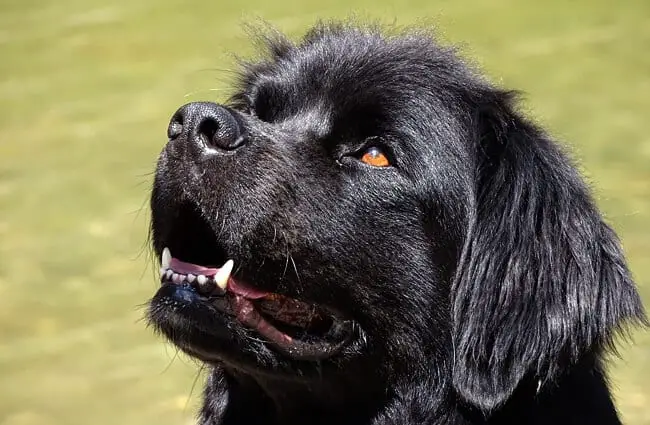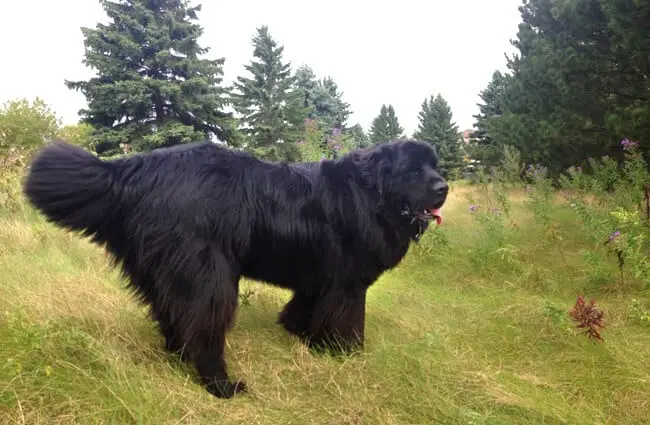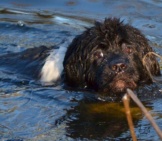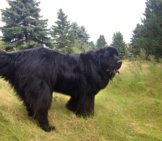The Newfoundland, or more affectionately known as the “Newfie,” is a giant dog with an even bigger heart. Known for a sweet temperament and gentle nature, this breed has earned a reputation as a “nanny” for children, but you should still probably hire a babysitter if you go out! But kids or not, Newfies are an excellent companion for anyone looking for a workhorse and affectionate dog rolled into one.
Excelling on land and water, this breed is sure to get the job done no matter what it is. Just make sure you are prepared to deal with all the baggage a big dog can come with, such as a large amount of slobber and fur. It can be challenging to convince a dog that might be bigger than you to move over on the couch! Read on to learn more about the Newfoundland.
Description of the Newfoundland
The Newfoundland is a heavy-boned and heavily-furred dog. Their immense size and gentle nature give them the appearance of being slow giants, but these dogs can really move when they want to.
Bred in Canada to work on fishing vessels, these dogs are no strangers to the water and their skills shine in this area. With thickly insulated fur, webbed feet, and lots of muscle, these dogs are strong enough to save a grown man from drowning. In fact, agencies such as the U.S. Coast Guard and the Italian Coast Guard still use them as water rescuers today!
But their working blood means they are strong no matter the situation, and they are excellent at pulling carts and working on land.
The Newfie has an immense head that sits nobly on his broad shoulders. The expression in the brown eyes of the Newfoundland is always one of kindness, intelligence, and loyalty. They have a thick double coat that is water resistant, coarse on top, and soft underneath. This can be brown, black, gray, or black and white.
Life Expectancy and Size
As with most big breeds, the Newfoundland has a shorter lifespan and lives an average of 9 – 10 years. They also can be susceptible to health issues that may shorten their lives drastically. Be sure to work with a reputable breeder so you can get the healthiest puppy, but always be prepared to deal with health problems as they can arise at any time.
These giant dogs are a sight to see. Males stand an average of 28 inches tall, and weigh 130 – 150 pounds; and females stand about 26 inches tall, and weigh 100 – 120 pounds. This size, along with their thick coat of fur, makes them a real life teddy bear.
Protective Ability
Protective and watchful over their families, and especially children, the Newfie is a natural guardian. They are a loyal breed and always on the lookout for trouble. But this sweet and calm dog is protective without being overbearing, and their natural friendliness towards strangers means they may not be the tough guard dog you are looking for. The Newfie is better prepared to protect you from drowning than from strangers.
Training
Eager to learn, patient, and outgoing are all excellent personality traits that make the Newfoundland a fast learner. This breed can pick up anything, so begin training as soon as you bring your puppy home.
As trusting and gentle dogs, the Newfie does best with positive training and consistent and kind praise. They thrive on this type of positivity so always come to training sessions fresh so you can give your dog this important attention.
Treats are also an excellent tool to use in training your dog. While the Newfie loves to work with you, and will be excited to train, having treats will make him even more motivated. Be sure to feed in moderation, though, is this breed can become overweight and this will put serious strain on their health.
As such smart dogs, the Newfie is an excellent choice for various canine sports. They also are water dogs so if you plan on training them for water work begin introducing them to water when they are around four months old.
Energy Level
The Newfoundland is a strong dog, and is used to hauling big loads and working long days. But they are quite even-keeled and tranquil. These dogs need daily exercise, but are often happy being more laid back.
Newfies can do well in a home with an active family or more sedentary family. They are quite adaptable, but despite being more relaxed in energy levels they still need plenty of room to move around so small apartments or homes may not be the best choice for this breed.
What Living with a Newfoundland is Like
This is a big breed with a big heart.
These dogs are the ultimate kid friendly breed. They have one of the sweetest and most patient temperaments of any breed and make an excellent companion for anyone looking for a loving and caring dog.
Their adaptability makes them a great companion for active and less active families alike. Happy to go on long walks or laze on the couch, the Newfoundland is a companion whose first priority is family. You will have a great friend for any adventure in this breed.
Care of the Newfoundland
These dogs are adaptable and easygoing. They can do well in any home as long as they have enough room and someone to give their love to.
Environmental Needs
Bred as workers on the high seas of the Atlantic, these dogs were designed to withstand icy waters and winter climates. Their weather resistant and insulated double coat provides plenty of warmth. But this breed can also adapt to warmer climates. Be sure to keep them out of extreme heat, though, as they can easily overheat when the temps soar.
Exercise Needs
Strong and steady is the name of the game for this breed. They can be playful and energetic, but are often more relaxed and gentle. At least half an hour of moderate exercise everyday is often enough to keep these dogs healthy and happy. Canine sports are also a great way to get your dog moving and provide them with some mental stimulation.
As natural water dogs, the Newfoundland can also get their exercise and enjoyment from playing in the water. This is also an excellent choice of activity for puppies, as young Newfies should have vigorous land playtime limited because their joints are still forming.
Shedding and Grooming
The heavy coat of the Newfoundland should be brushed a few times a week to keep it healthy and mat-free. These dogs shed seasonally twice a year so daily brushing will be a must at these times to keep the flying fur to a minimum. The Newfie is also a big drooler, so always have wipes handy to keep their spittle from getting everywhere.
This breed sheds moderately.
Regularly trim your dog’s nails and clean his ears to avoid potential problems.
Ideal Home Environment
The Newfoundland can do well in any home with enough space to move and lots of love. These dogs are warm and affectionate, doing best where they will be a real part of the family.
They are especially good with children and can do well with other pets they are raised with. You can expect an ever patient and protective dog in your Newfie.
Health Concerns
Orthopedic problems are some of the biggest issues that can plague this breed. Be mindful of your dog’s exercise when he is a puppy, as their bones are most vulnerable.
Other problems include cardiac disease, cystinuria, ear infections, and bloat. Always work with a reputable breeder, and ensure your dog is getting regular check-ups to catch, treat, or prevent problems early.
Behavior Problems
These dogs are incredibly affectionate and need close companionship to be happy. This means they can be prone to separation anxiety if left alone for too long. It is important to recognize that this is a sensitive breed and always provide them with contact. Never use isolation as a punishment.


























![Red Angus Closeup of a beautiful Red Angus cowPhoto by: U.S. Department of Agriculture [pubic domain]https://creativecommons.org/licenses/by/2.0/](https://animals.net/wp-content/uploads/2020/03/Red-Angus-4-100x75.jpg)

